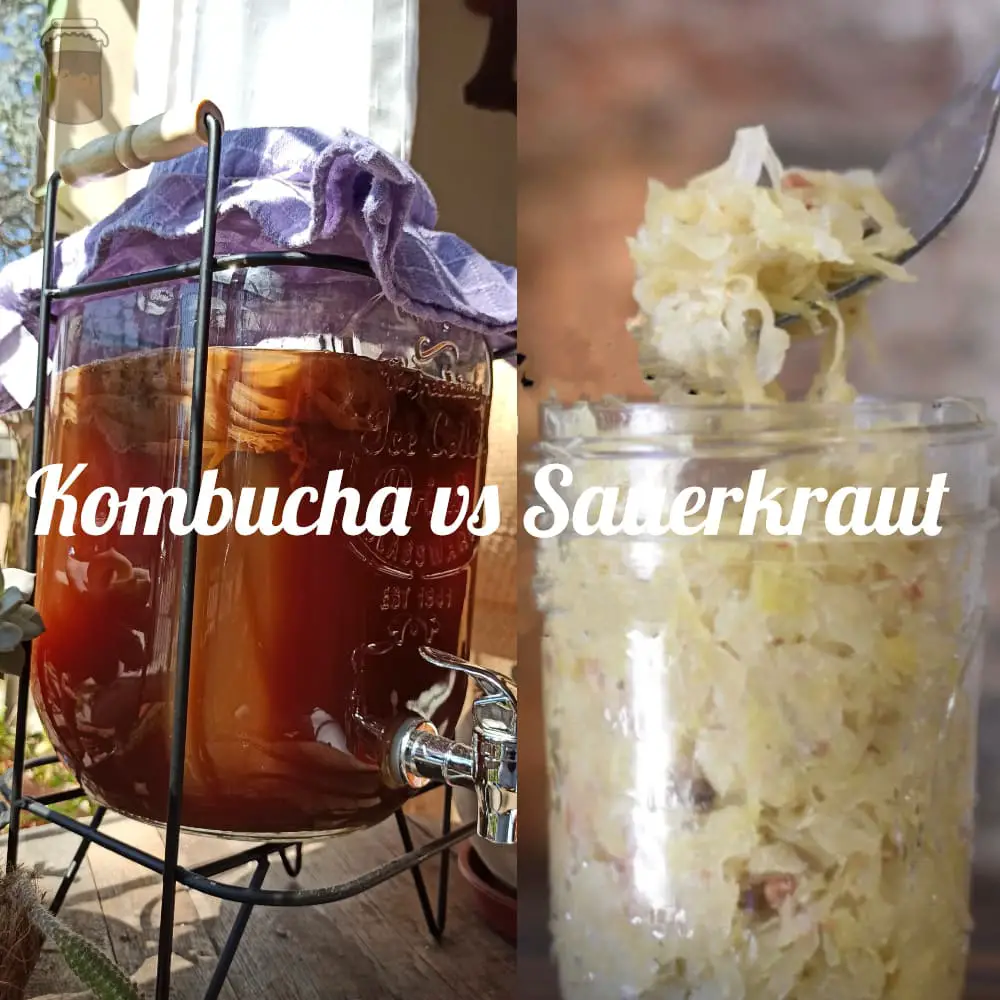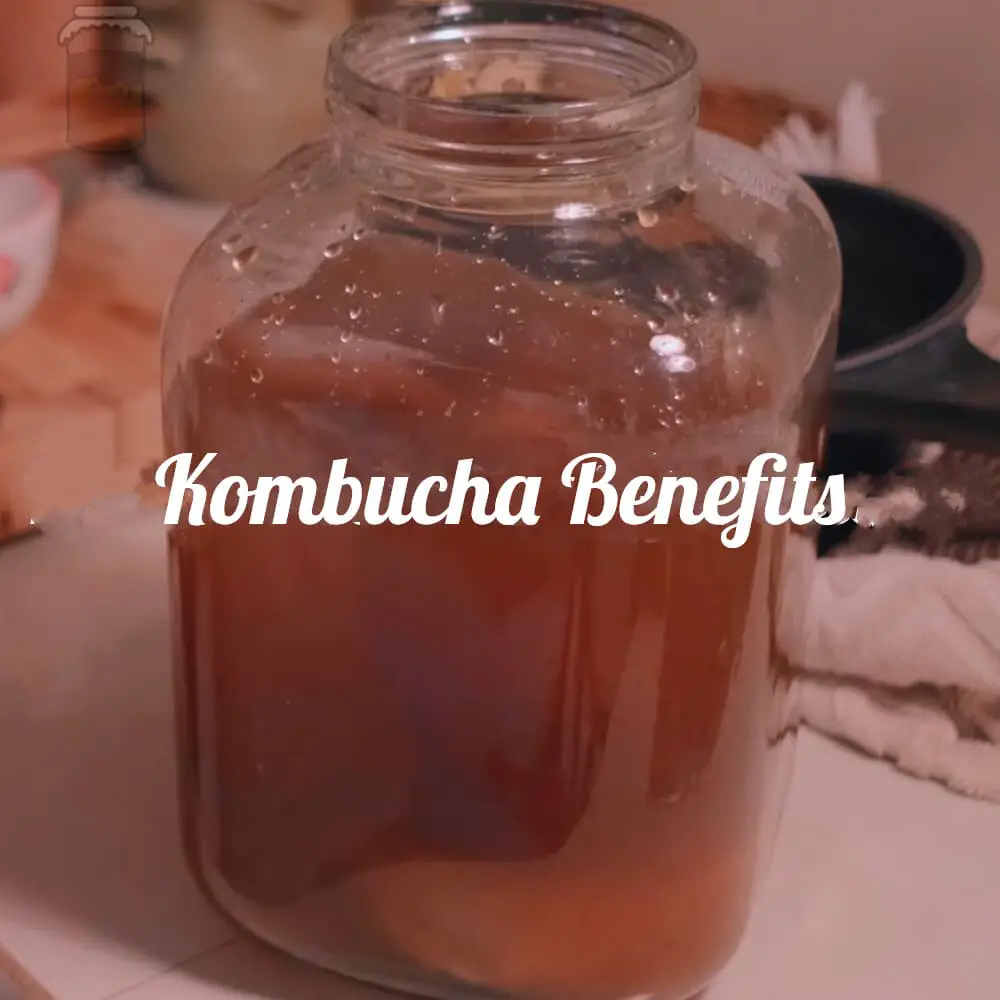
Kombucha vs sauerkraut, both are foods rich in probiotics, but they have essential differences that we will analyze; for example, in the case of kombucha, an initial culture is required, and in the case of sauerkraut only an external agent such as salt is needed.
According to the World Health Organization (WHO), [1] ingesting these probiotics in sufficient quantities has beneficial health effects, such as contributing to the intestinal bacterial flora of the host and boosting the immune system.
Sauerkraut is a solid food of Chinese origin based on white cabbage, unlike kombucha, a fresh drink of Chinese origin based on green or black tea.
So it is essential to investigate the general characteristics of these two foods, such as their benefits, the different living microorganisms present, their preparation, their fermentation condition, their origin, and their sensory characteristics.
What do sauerkraut and kombucha have in common?
Both are probiotic foods fermented by different non-pathogenic live microorganisms that help balance and develop the intestinal microbiota. In this case, the benefits provided by these products are pretty similar on both sides.
These benefits help optimize health, and even medical articles describe their use to combat different diseases, ranging from diarrhea to cancer prevention. However, many trials are based on animal experiments, not humans. [2]
Both products originate from China, made since ancient times, where fermentation has been practiced for many years and has proven to be an excellent resource to preserve food and take advantage of its nutrients.
As for their microorganisms, they use certain bacteria that produce lactic acid and acetic acid, components related to the benefits it brings to the body and as a tool for food preservation.
What are the benefits of sauerkraut and kombucha?
In sauerkraut:
- They help in the digestive process.
- They strengthen the immune system with high vitamin C content and probiotics present.
- Intestinal infections are reduced by restoring the intestinal bacterial flora with the intervention of probiotic microorganisms.
- They are involved in the absorption of calcium, iron, and phosphorus.
- They eliminate toxins by having antioxidant properties.
- Strengthening of bones by calcium content.
- Low calorie
In kombucha:
- Strengthens the immune system by the presence of vitamin C.
- It stimulates the digestive process by balancing the intestinal bacterial flora.
- It is low in calories.
- It protects the intestine against infections due to the production of immunoglobulins, the action of probiotics. 2
Contraindications of sauerkraut and kombucha
In general, there is scientific evidence that these foods are NOT RECOMMENDED in IMMUNOSUPPRESSED patients, for causing infectious pictures and especially in the case of sauerkraut by the bacterium Leuconostoc Mesenteroid, given that the defenses are significantly compromised or deficient. [3]
Kombucha is NOT RECOMMENDED in patients suffering from Gastroesophageal Reflux since the pH of kombucha is very low, and it is not recommended in pregnant women and children under six years of age due to its alcohol and caffeine content.
Recommended dose to consume sauerkraut and kombucha.
Kombucha: A natural drink, it starts with a daily intake of “120 to 240 ml”. In the case of diabetes, consumption can be in less quantity per day so as not to alter blood glucose levels due to the sugar added to kombucha.
This gives rise to 2 articles that we have raised for you. The first is about the best times to drink kombucha, and the second is the recommended daily doses of kombucha.
Sauerkraut: A healthy food that contains antioxidants and anti-inflammatory action, it is crucial to take care of the amount and not abuse its consumption, so ingesting this probiotic as a condiment for your main meals would be a good option about 2 or 3 times a week, about three tablespoons per serving approximately.
Are the probiotics in sauerkraut and kombucha the same?
They are not the same, they may have some in common, but essentially they are pretty different.
In the case of sauerkraut, we have lactic acid-producing bacteria such as Lactobacillus Plantarum and Leuconostoc Mesenteroid. [4]
In the case of kombucha, Schizosaccharomyces, Saccharomyces cerevisiae, Acetobacter, and more. [5]
In the next section, we will talk more about this.
Main differences: kombucha vs sauerkraut
As the differences between these two sources of probiotics are quite a lot, we will focus the debate on several aspects to show these differences more clearly.
Origin
Both have a similar origin, but we will characterize it because a myth is involved.
Sauerkraut comes from the Asian continent, exactly from China, which contrasts with what many say is from Germany, since in addition, Sauerkraut in English is Sauerkraut, a German word.
Kombucha also comes from the Asian continent, specifically China.
Raw material and its preparation
In sauerkraut, the raw material is white cabbage. It is a vegetable of the cruciferous family, with a high calcium and vitamin C content.
The elaboration process begins with a base of white cabbage, cleaning the vegetable, then finely cutting the fresh leaves, previously removing the stem. Subsequently, sodium chloride or salt is added to begin fermentation. Then, a heavy utensil is pressed to extract all the moisture and cover the cabbage strips completely. Finally, it is packaged in a glass container previously sterilized and covered so oxygen does not enter the preparation.
In kombucha, the raw material is green or black tea, which, like sauerkraut, is high in vitamin C and sugar.
The brewing process begins when a symbiotic culture of bacteria and yeast is added to the cold-sweetened tea for fermentation. This is placed in a glass container with a cloth that allows air circulation without letting dust or insects enter. Then, depending on the desired flavor, the mixture sits for weeks. Click here if you want more information about how to prepare kombucha.
Microorganisms present
In sauerkraut, we have the following bacteria: Leuconostoc mesenteroides, Lactobacillus plantarum, Pediococcus pentosaceus, Lactobacillus brevis, Leuconostoc citreum, Leuconostoc argentinum, Lactobacillus paraplantarum, Lactobacillus coryniformis, and Weissella sp.
In kombucha, we have: Acetobacter xylinum, Gluconobacter bluconicum. Schizosaccharomyces pombe, Schizosaccharomyces cerevisiae, Saccharomyces boulardii, Zygosaccharon bailii, Kloecera apiculata, Brettanomyces bruxellensis, Brettanomyces lambicus, Brettanomyces Custersii, Candida stellata.
Fermentation conditions
For sauerkraut, developing its microorganisms requires a temperature of 20 to 25°C with a fermentation time of 14 to 21 days. The fermentation process involves the sequential growth of various types of microorganisms.
During the early stages, lactic acid bacteria such as the Mesenteroid leuconostoc species develop. And after eight days of fermentation, homofermentative lactic acid bacteria (not gas-producing) such as Lactobacillus Plantarum appear.
It is essential as a fermentative element to salt or sodium chloride concentration. If you add more salt than the necessary amount, it will inhibit the growth of these microorganisms, and if a small amount is added, it will result in the development of other opportunistic and pathogenic bacteria.
It is the same with the temperature and pH, which should be between 3.1 and 3.7.
In kombucha, it is fermented with an average ambient temperature of 22 to 30°C (71°F-86°F), which requires approximately 7 to 15 days to finish fermenting.
For the fermentation process, adding sugar is required as a conductive element for the production of lactic acid in the bacteria producing this chemical compound and the preservation of the product with an adequate temperature and a resulting pH of 2.5 to 3.5.
The fermentation process of kombucha is super important, so I leave you the dedicated article where you will find more information.
Nutrients
In sauerkraut, its high content per 100 mg stands out: calcium at 47 mg, vitamin C at 32.2 mg, phosphorus at 23 mg, and carbohydrates at 5.43 mg. It should also be noted that it has enough humidity at approximately 92%, low in calories. Compared to other vegetables, this is considered high in vitamins and minerals.
In kombucha, it stands out for its content of vitamins such as B1 (thiamine), B2 (riboflavin), and B3 (niacin). In addition, it is high in vitamin C (ascorbic acid), essential oils, and minerals such as magnesium, zinc, phosphorus, and iodine.
Taste
Sauerkraut has an acidic taste but is somewhat flat. It is similar to kimchi but has less seasoning and a more salty sensation.
As we have often said, kombucha is like an apple cider and vinegar mixture.
Color
Sauerkraut has a little white like cabbage but gets a little more yellowish.
Kombucha has an initial color equal to that of a cup of tea (reddish) that lightens with fermentation time.
Texture
It has that crunchy touch you can feel in cabbages in general, like it does with kimchi.
Kombucha is dramatically different from sauerkraut because we are comparing a drink against a solid food.
Aroma
It is curious, but sauerkraut has an acidic smell, not as much as we find it in vinegar. Still, because of its aroma, it also gives the impression that it is salty. It is a strange sensation.
Kombucha smells much more like vinegar, so kombucha vinegar can be created when fermenting this product for a long time.
In summary, we will clarify some of the main differences in a comparative style chart to make it more straightforward and more concise for readers.
| Characteristics | Sauerkraut | Kombucha |
| Origin | China | China |
| Raw material | White cabbage | Black or green tea |
| Microorganisms | Bacteria | Bacteria and yeasts |
| Fermentation time | 14 to 21 days | 7 to 15 days |
| Fermentation temperature | 20 to 25°C | 22 to 30°C |
| Calories | Low calorie | Low calorie |
| Taste | Acidic | Acidic or slightly sweet |
| Aroma | Very mild vinegar | Slightly vinegary |
| Colour | White | Brown or reddish |
| Texture | Crusty | Liquid |
| Recommended dose | 2 or 3 tablespoons | 120 to 240ml daily |
With this, we finished the comparison of kombucha vs. sauerkraut, which we hope you liked. If so, we have other comparisons that can be very useful, so stay and discover this whole world of fermented food.
References
[1] https://www.fao.org/3/a0512e/a0512e.pdf
[2] https://onlinelibrary.wiley.com/doi/pdf/10.1111/1541-4337.12073
[3] https://www.sciencedirect.com/science/article/abs/pii/B9780123744074002673






